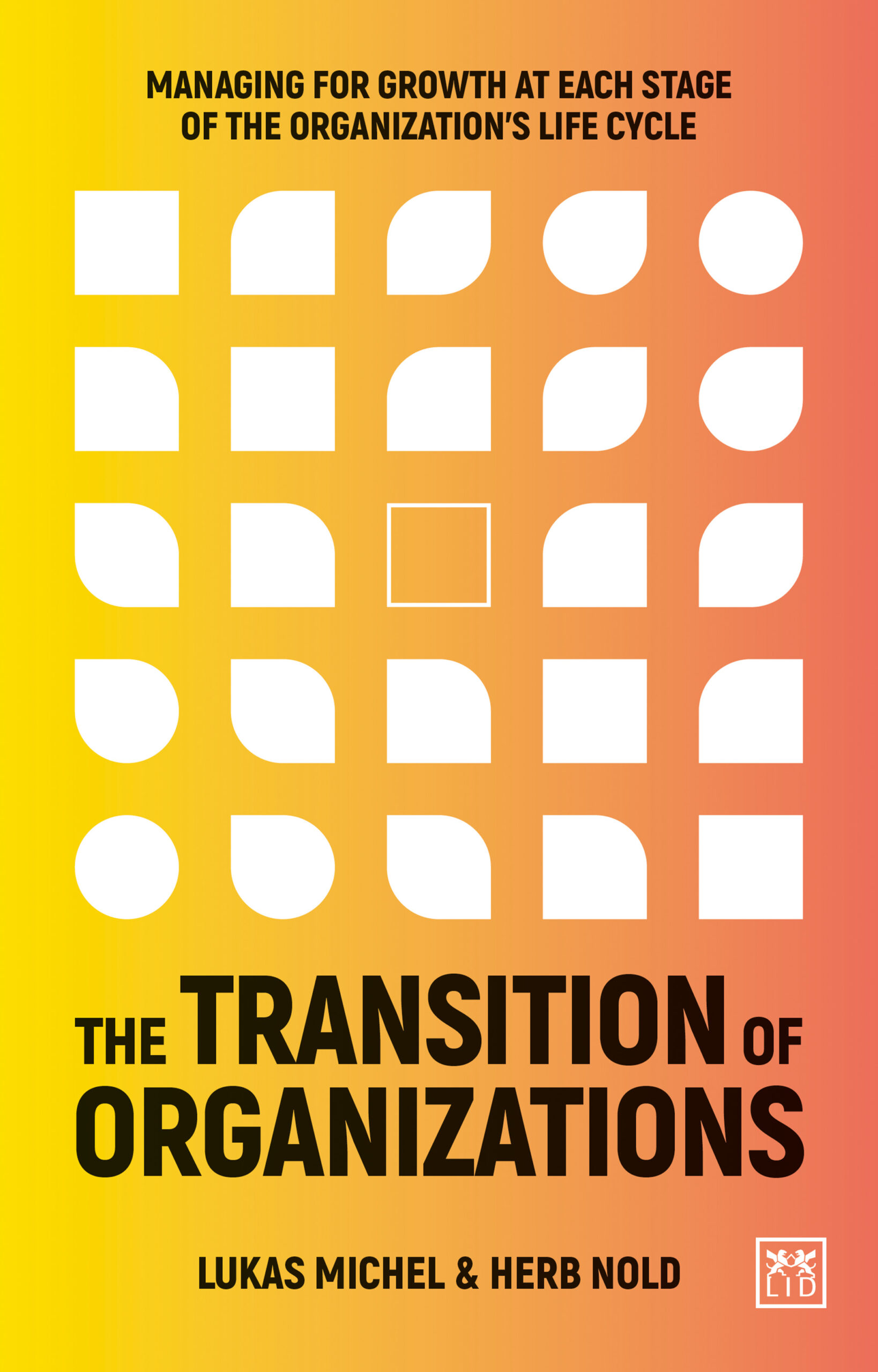|
Solving the Crisis of Sovereignty with Lukas Michel & Herb Nold
Solving the Crisis of Sovereignty

By Guest Contributors Lukas Michel & Herb Nold
Authors of The Transition of Organizations, Lukas Michel and Herb Nold, reveal how leaders can solve the crisis of sovereignty as their company enters the final, fifth stage of its life cycle.
The Transition of Organizations is the result of 20 years of work with clients around the globe and the related research that enabled us to conclude that there are patterns of deliberate strategies companies can follow to overcome their inherent structural crises.
Organizational growth follows five life cycle stages: creativity, direction, delegation, coordination, and collaboration. Every stage comes with specific evolutionary and revolutionary attributes, followed by a crisis or organizational challenge that must be overcome to advance to the next stage. We evaluate organizations by looking at their structure through the lens of viewing management as a competitive advantage. Mapping management patterns using the Leadership Scorecard tool allows us to identify the dominant management style for each life cycle stage.
More on the GROWTH LIFE CYCLES
The collaboration stage. Complexity increases as companies continue to grow with the introduction of functional departments and quasi-independent profit centres or business units. With the formation of far-flung segments, additional structures like matrix organizations, networks and ecosystems of all types may be introduced to facilitate collaboration. Interaction among widely disparate components is needed to solve problems and promote innovation and efficiencies that drive further business growth. The need for flexible controls grows as complexity increases. The potential loss of organizational identity creates the crisis of collaboration that must be resolved to continue successful growth. Four steps provide guidance to overcome the crisis of sovereignty.
The network organisation. To overcome the barriers of red tape, the organization now develops a more flexible and versatile network structure. Various forms of matrices link organizationally and geographically separated business segments to facilitate the internal flow of knowledge. The management focus is on solving problems quickly in teams drawn from multiple segments. Teams are formed to handle specific issues by drawing on expertise from various disciplines. Typically, headquarters-level functional staff experts are reduced in number, reassigned, and integrated into interdisciplinary teams that consult with business unit or segment teams.
- A matrix or network structure is used to assemble teams composed of people with expertise needed to address the issue the company is working to resolve.
- Conferences with key executives are held to identify complex problems and then focus essential resources and personnel on resolving them.
- Educational programmes become widely used to train managers in behavioural soft skills needed to facilitate effective teamwork and conflict resolution.
- Experimenting with new practices and technologies, particularly communication technologies, are encouraged.
Crisis of sovereignty. At this phase, extensive collaboration through matrices and networks increases complexity. Collaboration in both face-to-face and advanced communications technology modes opens doors for further growth through cooperation and alliances in ecosystems that may extend beyond the boundaries of the original organization. Strategic alliances, joint ventures or other business forms facilitated by collaboration can emerge to fuel further growth. The emergence of alliances in ecosystems means that the organization loses some of its original identity. The crisis of complexity resolved through collaboration leads to the crisis of sovereignty. The challenge for leaders becomes retaining the identity, processes and philosophy that drove growth from the creativity stage to the collaboration stage in the emerging ecosystem.
Complexity increases, leading to the development of matrix and network organizations that require interaction among the members to collaborate and get things done. Members in the emerging alliances or ecosystems may be external organizations. Consequently, the crisis of sovereignty will emerge. Further growth comes from continuously applying the four steps of managing transitions.
Managing Transitions. Organizational growth follows five stages. Four transitions, from one stage to the next, build the structures, capabilities and systems needed to navigate through the life cycle. Managing these transitions becomes every manager’s job, with mastery of better management principles as the target. By managing these transitions effectively, organizations can convert their management from a necessary burden into a competitive advantage.
Diagnostic mentoring creates the learning experience needed to successfully transform the organization using better management practices. Awareness, insights, and learning guide your journey, with proven tools to engage the entire team.
Step 1: Raise awareness for the transition. Diagnostics using proven tools establishes quantifiable observation points. Monitoring is a discipline that can be used to observe the current state and alter design for an improved future state. By observing (scanning) capabilities, potential faults and malfunctions that are typically overlooked can be spotted at an early stage. By becoming aware of critical but unseen signals, potentially beneficial design requirements can be identified. In this way, leaders can decide whether to address issues by taking targeted action. As such, monitoring initiates design changes to improve capabilities.
The Executive Survey. Capability monitoring with a professional, research-based survey tool creates awareness and the necessary insights for managers to develop people-centric, agile, and dynamic capabilities. The Executive Survey is an online questionnaire for managers and employees that takes less than a half-hour to complete. The results of the survey are documented in the Organization Twin. Conducting the assessment creates awareness and establishes a shared understanding of the context and the issues that require attention. Participating in the survey is a first intervention.
Step 2: Act on your insights on your transition. The Organization Twin distils the elements of better management into practical components. The application of agile principles, people-centric management, dynamic capabilities, and organizational design is selective. The decision to employ a specific design excludes other alternatives. The design process is about the selection of managerial tools, routines and rules that make for mastery in the unique context of the organization. Effective organizational design requires objective reflection and personal interactions. It is not free from internal politics, but enlightened leaders will make every effort to remain objective and minimize political infighting for the good of the organization. The setting and tone of these conversations determines much about the design’s quality.
The Twin of Management and Organization. Organizations create intangible assets–one cannot see and, therefore, not advance them. That’s why we build twins: Visible dynamic copies of real-world organizations. With them, leaders can view present conditions, anticipate opportunities, plan changes, test decisions, and transfer that experience into the real world. Objective reflection and dialogue about the results among executives triggers the thinking about how we do things here and what mastery in management looks like. Therefore, engaging people in the Organization Twin, and the following steps, means using the knowledge and brainpower throughout the organization to work on the system.
Step 3: Expedite the learning about your transition. The inner game describes the techniques for continuous learning. Monitoring assumes that the design can be changed and not frozen in place. While deeply embedded in organizational practices and rooted in the past, managerial design and capabilities can be changed through interventions. The shift to better management demands specific capability development projects that advance the decisions on what needs to be changed. In this way, the idea of permanent change is replaced by the notion of combining learning and doing into an iterative process of continuous improvement.
Work in the system. Mastering the transition to generate continued growth is to work in the system. With the people in mind, managers now can apply the four principles of working in the system as a roadmap to continue making transitions to higher levels with their team. Managing continuing transitions follows principles of work in the system – the foundation of digital leadership:
Applying better management techniques is working in the system. You should expect all your managers to follow these four principles and develop their enabling approach to management, which caters to the people as individuals.
Why guess if you can know? Diagnostic mentoring is the three-step process to help organizations succeed with the life cycle transition. It provides deep insight into unseen and rarely discussed elements of systems, leadership, and culture. Major organizational transformations require leaders at the top to adopt a new mindset that views people as self-responsible. Top executives must recognize that all components of the organization are closely interconnected, in a complex web of dependent relationships. It is the manager’s responsibility to drive the transformation.
Key words: collaboration – the network organisation – crisis of sovereignty – four steps to manage transitions.
————————————————————————————————————————————————
Bibliography: Greiner, L. E. (1998). Evolution and Revolution as Organizations Grow. Harvard Business Review: Mai-June.
ABOUT THE AUTHOR

Suggested Reading
 The Transition of Organizations explores various common patterns of management styles and then offers transition strategies to help managers succeed in the digital economy. The authors guide leaders to prepare for these transitions by laying the foundations or infrastructure needed to prevent a crisis that inhibits further growth. They also provide leaders with a greater understanding of the growth framework, which will help leaders to manage better the development of their companies.
The Transition of Organizations explores various common patterns of management styles and then offers transition strategies to help managers succeed in the digital economy. The authors guide leaders to prepare for these transitions by laying the foundations or infrastructure needed to prevent a crisis that inhibits further growth. They also provide leaders with a greater understanding of the growth framework, which will help leaders to manage better the development of their companies.

